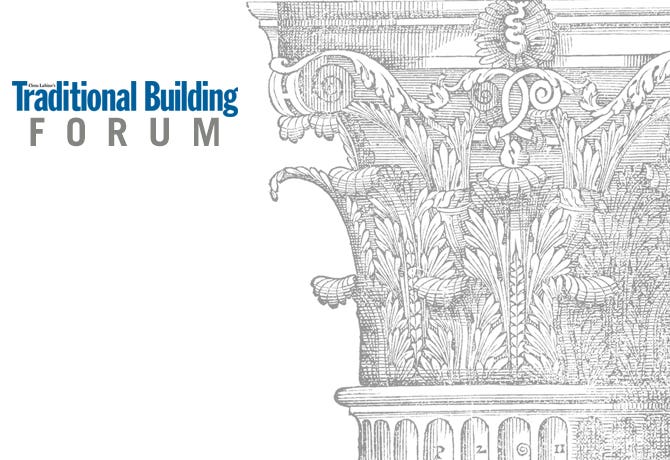
The Forum
Challenging Architecture’s Caste System
By Clem Labine
Elsewhere in this issue, Dean Mark Gelernter of the University of Colorado Denver School of Architecture sets out a point-by-point refutation of the major arguments routinely trotted out to assert the supremacy of Modernist architecture over traditional design. (And by Modernist architecture, I am referring not only to Bauhaus glass boxes, but also to all the other exotic "-isms" that have followed.) The logic in Dean Gelernter's argument is, if not irrefutable, at least grounds for a substantive debate at the highest levels of the architectural establishment. But it is highly unlikely such a debate will take place.
Unfortunately, it's not sufficient to explode the myths of Modernist
architecture with the power of reason. The unhappy reality is that Modernist theory has assumed the status of religious orthodoxy within the architectural establishment. So many people and institutions have bought into the ideology of Modernism that they cannot afford to let themselves question its underlying assumptions. Should Modernist doctrine prove to be unsound or untrue, it would topple the caste system that has evolved in the architectural profession over the last seven decades.
The caste system, which had its inception in the architecture schools before World War II, is based on the presumed moral and intellectual superiority of Modernist theory. Many of the original social justice and egalitarian tenets of early Modernism have been long forgotten. But what remains as the fundamental article of faith in Modernist theology is the belief that any design with deliberate reference to architecture prior to 1910 is sacrilege.
Brahmins at the top of today's architectural caste system assert that all architectural tradition is irrelevant. Practitioners of Classical and historically influenced design are deemed inferior and consigned to a lower-status caste – and are considered by many of the elite to be "untouchable." Need proof? :
- How many U.S. schools of architecture consider historically influenced design a valid option?
- How long has it been since a traditionalist architect reached high office within the American Institute of Architects?
- When has a traditionalist architect won a Pritzker Prize or an AIA Gold Medal?
- When was the last time traditionally designed architecture received a sympathetic review in the mainstream architectural press?
- How many traditional architects serve on juries that judge proposals for important public commissions or national architecture awards?
- Why is GSA's "Excellence in Design" program interpreted as "Excellence in Modernist Design"?
- When was the last time a traditional design was selected for an important public project (e.g., the Eisenhower Memorial)?
The Great Mistake
Architectural Brahmins' conviction that they alone possess the truth engenders no end of economic and civic mischief. The certainty that ornament is a crime and traditionalist architecture is nostalgic fantasy foments a never-ending quest for the "shock of the new" – often taken to absurd extremes. This is the great mistake of Modernism, for it overlooks the reality that tradition is a collective form of human knowledge and experience. To summarily reject humankind's accumulated wisdom is the height of hubris. In architectural practice, this hubris has caused countless historic areas to have their special character disrupted by insertion of aggressively contrasting structures. Taxpayers and clients, seduced by the promise of "iconic buildings," often discover that the geometrical complexity of these one-off structures makes them problematic to construct, difficult to maintain, and far more expensive than original estimates.
Numerous surveys show that radical architecture is not terribly popular with the people who have to look at and use those buildings. In the AIA's own list of "America's Favorite Architecture," nine of the top 10 are historically influenced structures. But the architectural Brahmins dismiss the opinions of the general public as well as that of their traditionalist colleagues. One of the high priests of the Modernist establishment, British architect Richard Rogers, asserted the authority of high-caste professionals when he proclaimed: "architecture . . . has to be judged by those who are qualified to judge it." And architect Piers Gough summarized Brahmin attitudes most clearly when he declared: "Architecture is a public art, but it's far too important to be left to the public."
Modernism Is Just Another Style
That's why the issues Dean Gelernter raises are so revolutionary. Should these challenges to Modernist shibboleths gain acceptance, it reduces Modernist architecture to merely a historical style – just one of many that have waxed and waned over three millennia. It would mean that traditional and Modernist design should be accepted as intellectually and aesthetically valid equals, the proper choice being governed merely by project needs and context. But the suggestion of stylistic equality undermines the foundation of the architectural caste system, and would deprive Brahmins of the privileged status they have enjoyed for many decades.
Few professionals over 30 who have bought into Modernist ideology will give serious consideration to Dean Gelernter's arguments because it is too threatening to have long-held beliefs challenged. Therefore, the long-term goal must be to reach young architects before their belief systems become deeply rooted. Some progress is already being made. The Institute of Classical Architecture & Art offers a wide and growing array of continuing-education programs in Classical design through its New York headquarters and 15 regional chapters. Yale University's School of Architecture, under Robert A.M. Stern, is now exposing its students to both sides of architecture's ideological schism. And architecture schools such as Notre Dame and the University of Miami offer instruction in traditional design and urbanism.
As individuals, we should also seize every opportunity to give lectures and teach classes as visiting faculty. Education is the most powerful weapon with which to challenge the entrenched architectural caste system. It'll take years. But it can be done.
Clem Labine is the founder and Editor Emeritus of Traditional Building. He is also founder of Period Homes, and The Old-House Journal magazines. He is currently an independent consultant specializing in website optimization and marketing.









